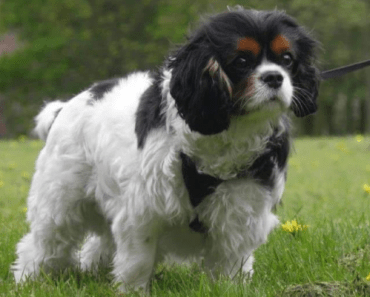Cavalier Crufts best of breed winner makes mockery of KC’s “healthy, happy dogs” say canine health campaigners.
Canine health campaigners have expressed their disappointment and Cavalier online forums are buzzing with disbelieving and angry comments as it emerged that the Crufts Best of Breed title winner fathered a litter of puppies at nine months old. This flies in the face of breeding protocols for Cavaliers, a breed beset by inherited health issues.

“Because there is no simple DNA test for Mitral Valve Disease (MVD) and Syringomyelia (SM), the two most serious inherited conditions suffered by Cavaliers, it is absolutely crucial that dogs are not bred before 2.5 years and that they continue to be tested throughout their life,” says long-time campaigner Margaret Carter, whose online petition asking the Kennel Club to make testing for MVD and SM mandatory has amassed over 25,000 signatures.
You’re My Sunshine Vom Kaninchengarten, a Blenheim Cavalier, is less than two years old and has heart and eye tests recorded after he fathered a litter. “For years the majority of Cavalier breeders have ignored MVD and SM breeding protocols even though these were established nearly two decades ago. This Crufts win not only exemplifies why the Kennel Club needs to get tough but it also makes a mockery of its claim that Crufts is ‘Celebrating healthy, happy dogs’,” adds Carter.
All of the current top five Cavalier Club “best stud dogs” all produced litters before their second birthday. “The fact that the Best of Breed Cavalier was, according to official online records, used for breeding while still a puppy himself underlines why the breed remains under such tremendous and devastating genetic health pressure,” claims Karlin Lillington, owner of the forum CavalierTalk.com and co-founder of Rupert’s Fund, which has raised over £30,000 for health research and breeder MRI scans.
“For a top show exhibitor to breed a Cavalier so young that it would still compete in puppy show classes, and only heart test months later – when it is still too young to be meaningful in a progressive disease – indicates that clubs remain unable or are unwilling to motivate breeders to breed for health. Therefore, testing should be made mandatory for litter registration.”
Donna Farrand’s Cavalier, Freddie, underwent decompression surgery last year to help improve his SM symptoms. Freddie’s father sired a litter at just over a year old and continues to be used for breeding. “I was furious to see the owner of his sire judging one of the Cavalier rings yesterday. What kind of message does this send out and what kind of example does this set to other breeders?” she asks.
On some online forums, breeding at a young age has been defended but Lena Gillstedt, a Cavalier breeder and biologist from Sweden where testing for Cavaliers is compulsory, says this is nonsense: “If males needed to be proven at nine months to know what to do, the breed would be extinct in Sweden because here no Cavalier can be bred until it is at least 24 months. But here the breed is actually thriving.”
Canine health campaigner Carol Fowler, founder of the Dog Breeding Reform Group, says: “A Cavalier Breed Clubs’ heart scheme was agreed almost 20 years ago. If only all breeders had followed its recommendations, including that no dog under 2.5 years should be bred, we would have seen a marked improvement in early onset MVD by now. However, success in the show ring, glory for the owner and the resulting stud fees are seemingly more important.”
See the petition at https://www.change.org/p/the-

Leave a Reply